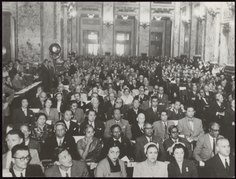| Part of a series on |

Resolution IV.4.422-4224, commonly referred to as the Montevideo Resolution, is a resolution passed in Montevideo, Uruguay on December 10, 1954 by the General Conference of UNESCO. The resolution officially supports the constructed language Esperanto as an international auxiliary language and recommends that the Director-General of UNESCO follow current developments in the use of the language. The Montevideo Resolution was the result of a long campaign by Ivo Lapenna.
Contents
In 1977, the Director-General visited the World Esperanto Congress in Reykjavík, Iceland, and in 1985, UNESCO passed a further resolution recommending that member countries encourage the teaching of Esperanto.
